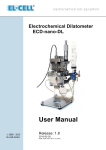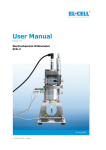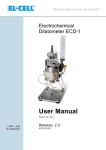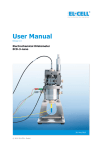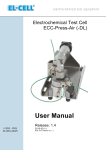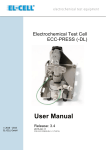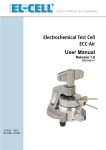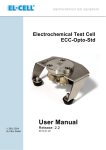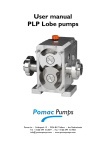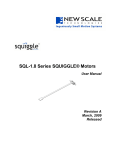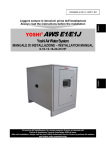Download User Manual - EL-CELL
Transcript
Electrochemical Dilatometer ECD-2-DL User Manual © 2007 - 2015 EL-Cell GmbH Release: 1.8 2015-02-27 PCB: ECD-2-DL 8.2 The information in this manual has been carefully checked and believed to be accurate; however, no responsibility is assumed for inaccuracies. EL-Cell GmbH maintains the right to make changes without further notice to products described in this manual to improve reliability, function, or design. EL-Cell GmbH does not assume any liability arising from the use or application of this product. EL-Cell GmbH Tempowerkring 8 D-21079 Hamburg Germany phone:+49 (0)40 790 12 733 fax: +49 (0)40 790 12 736 e-mail: [email protected] web: http://el-cell.com Page 2 of 34 ECD-2_manual / 27/02/2015 Contents 1 Product Description .................................................................................... 4 2 Technical Specifications .............................................................................. 5 3 Safety Precautions ...................................................................................... 6 4 Unpacking.................................................................................................. 7 5 Dilatometer Assembly ................................................................................. 8 6 EC-LINK Software Installation ................................................................... 20 7 Settings and Calibration ............................................................................ 20 8 Recording the Displacement Signal with an External Potentiostat ................ 21 9 Dilatometer Disassembly ........................................................................... 22 10 Using the Reference Electrode .................................................................. 23 11 Using an Auxiliary Electrode ...................................................................... 23 12 Using Single Crystals or Grains as the Working Electrode (option) ............... 24 13 Spare Parts .............................................................................................. 26 14 Connector and Cable Pin-out ..................................................................... 31 15 Technical Support .................................................................................... 33 16 Warranty ................................................................................................. 34 Page 3 of 34 ECD-2_manual / 27/02/2015 1 Product Description The ECD-2-DL electrochemical dilatometer is dedicated to the measurement of charge-induced strain (expansion and shrinkage) of electrodes down to the submicrometer range. The ECD-2-DL has been particularly developed for the investigation of Li-ion battery and other insertion-type electrodes. It may, however, also be used for many other electrochemical systems utilizing organic as well as aqueous electrolyte solutions. The electrode materials used can either be bound film or single crystals/grains (e.g. HOPG or graphite flakes). The maximum sample size is 10 mm x 1 mm (diameter x thickness). The heart of the ECD-2-DL is an electrochemical cell, hermetically sealed against ambient atmosphere. The two electrodes inside are separated by a stiff glass frit that is fixed in position. The upper working electrode (WE) is sealed by means of a thin metal foil, through which any charge-induced height change is transmitted towards the sensor/load unit above. This working principle allows determining the height change of the working electrode without any interference from that of the counter electrode (CE). A high-resolution displacement (LVDT) transducer detects dimensional changes of the WE ranging from 100 nanometers up to 500 micrometers during one and the same experiment that may last between a few minutes to many days. The ECD-2-DL features an integrated USB data logger for recording the electrode displacement, temperature, cell potentials and current. Analog outputs of displacement and temperature are provided for integration with external instruments. For best accuracy and drift stability, the dilatometer is to be operated inside a temperature controlled chamber. Page 4 of 34 ECD-2_manual / 27/02/2015 Friction-free flexure guide Sensor plunger Weight load on WE (not exchangeable) Spacer disc for height adjustment Valve assembly for vacuum filling via syringe Metal membrane Auxiliary port Reference electrode assembly Glas T-frit Separates WE test Specimen on top from CE below Spring-loaded CE plunger Gas filled dead Volume to suppress changes in hydrostatic pressure inside cell 2 Technical Specifications LVDT sensor system with <50 nm resolution, drift stability of <100 nm/hour (sample-free instrument at constant temperature), and 500 µm full range. Conditioning electronics with analog output signals (-10 to 10 V) for displacement and temperature. Integrated USB data logger for recording of displacement, temperature, cell potentials and current. 3-electrode electrochemical cell Sample (working electrode): bound electrode film or single crystal / grain max. sample size 10 mm x 1 mm (diameter x thickness) Load on working electrode: 0.3 N or 1.3 N Electrolyte volume: approx. 2 mL Materials in contact with electrolyte: PEEK, borosilicate glass, EPDM rubber, stainless steel 316L for aprotic, gold for aqueous electrolytes Operating temperature range Cell and sensor: -20 to +70 °C Conditioning electronics and data logger: 0 to +40 °C Page 5 of 34 ECD-2_manual / 27/02/2015 Minimum dimensions for glovebox ante-chamber transfer (with stand detached) Dimensions (ECD-2 completely assembled on stand) 3 Safety Precautions Use proper safety precautions when using hazardous electrolytes. Wear protective glasses and gloves to protect you against electrolyte that may accidentally spill out of the instrument during filling, operation, and disassembly. Page 6 of 34 ECD-2_manual / 27/02/2015 4 Unpacking Check the contents of the packages against the list given below to verify that you have received all of the components. Contact the factory if anything is missing or damaged. NOTE: Damaged shipments must remain with the original packaging for freight company inspection. List of Components 1. ECD-2-DL dilatometer (in the assembled state) equipped for use with aprotic electrolytes 2. Signal conditioning electronics (controller box) with integrated USB data logger for recording the displacement, temperature, cell potentials and current 3. USB data acquisition software, Windows drivers and operating manual on CD 4. Cell cable (connects dilatometer cell with controller box) 5. Sensor Cable (connects dilatometer sensor unit with controller box) 6. 3 tubing assemblies for interconnection between cell, valves and syringe 7. 20 ml syringe for filling the dilatometer cell with electrolyte 8. Vacuum pipette and tweezers for electrode handling 9. Hex wrenches for assembly and maintenance 10. Activated carbon electrodes (5 pcs) for reference measurements Page 7 of 34 ECD-2_manual / 27/02/2015 5 Dilatometer Assembly The following photographs refer to the use of the dilatometer with aqueous electrolytes. For aprotic organic electrolytes, the assembly differs slightly as indicated in the respective figure captions. 1 Insert o-rings into cell body (21.95 x 1.78 and 41 x 1.78) 2 Insert glass frit (T frit 10/20 mm dia) into cell body Page 8 of 34 ECD-2_manual / 27/02/2015 3 Place CE (dia <= 20 mm) with the active layer downside on top of the glass frit 4 Place current collector disc on top of the CE NOTE: For aprotic organic electrolytes, this disc is not required. 5 Insert the central CE piston into the cell bottom (O-ring size 9.75 x 1.78 mm) NOTE: For aprotic organic electrolytes, use the stainless steel piston instead. Page 9 of 34 ECD-2_manual / 27/02/2015 6 Stack cell bottom (with central CE piston inserted) on top 7 Put base flange (with valve support attached) on top, hold the assembly tightly together, and turn it upside down 8 Screw the assembly together by means of the 3 Allen screws M4x25 Page 10 of 34 ECD-2_manual / 27/02/2015 9 Attach the cell to the bracket, and fasten it with the two knurled screws 10 Screw in the CE spring load from below to its uppermost position, then release it slightly by turning the screw back (ccw) by approx. 45° 11 Put the WE on top of the glass frit with the active layer downside. Page 11 of 34 ECD-2_manual / 27/02/2015 12 Place the spacer disc on top of the WE (gold for aqueous, stainless steel 316L for aprotic electrolytes). NOTE: Three different spacer discs (thickness 2.1, 2.2 and 2.3 mm) are provided to initially adjust the membrane for a given WE thickness close to its neutral (flat) position (see sketch below). Use the 2.3 mm disc for a sample thickness between 0 and 150 µm. WE Spacer disc Metal membrane T-frit CE Page 12 of 34 ECD-2_manual / 27/02/2015 13 Insert the membrane O-ring seal (33.05x1.78) 14 Insert the membrane (gold for aqueous, stainless steel 316L for organic aprotic electrolytes) 15 Place the cover flange on top Page 13 of 34 ECD-2_manual / 27/02/2015 16 Fasten the cover flange by means of the 3 Allen screws M4x30. 17 Interconnect cell, valves and tubing as indicated by the numbering on the parts. 18 Close the side opening with the provided plug. NOTE: Optionally, this plug may be replaced by an auxiliary electrode. Page 14 of 34 ECD-2_manual / 27/02/2015 19 Attach the reference electrode (gold reference pin for aqueous, SS pin for aprotic electrolytes). NOTE: The reference pin is to be loaded with the appropriate reference electrode material. Dead volume valve (red) 20 Syringe valve (yellow) Fill the cell with electrolyte according to the following procedure 1. Charge a 20 ml syringe with approx. 3 ml of electrolyte. We recommend onetime use PP plastic syringes with low friction polysiloxane pistons. 2. Connect the syringe to the Luer adapter of the inner (syringe) valve 3. Open the syringe valve, and close the outer (dead volume) valve 4. Pull the syringe piston back to evacuate the cell. Hold the piston a few seconds in the strained position. 5. Release the piston so that the electrolyte from the syringe replaces deliberately the previously removed gas. NOTE: Never pressurize the cell by pushing the syringe piston. 6. Repeat the two previous steps to complete filling. 7. Close the syringe valve, and open the dead volume valve NOTE: The cell is now filled and hermetically tight. Up to this point, for airsensitive systems, assembly and filling has to be done in a glove box. All subsequent steps may be carried out in ambient atmosphere. Page 15 of 34 ECD-2_manual / 27/02/2015 21 Securing screw Release the carriage securing screw, then move the carriage into the uppermost position by turning the micrometer screw clockwise 22 Attach the the sensor/ load unit to the cell 23 Fasten the sensor/ load unit by the two Allen head screws Page 16 of 34 ECD-2_manual / 27/02/2015 24 Place the dilatometer inside a temperature controlled chamber at a constant temperature between -20 to +70°C. Connect the round connector of the sensor cable to the LVDT sensor. Turn on the sensor electronics by connecting the controller box to the 24 V power supply. Connect the 2 mm banana plugs of the cell cable to the dilatometer cell. Page 17 of 34 ECD-2_manual / 27/02/2015 25 Unlock the flexure guide by turning the locking screw 90° counter clockwise 26 Adjust the sensor target by turning the micrometer screw counter clockwise until the bar graph indicator at the controller box is approximately in mid position. Page 18 of 34 ECD-2_manual / 27/02/2015 27 Fasten the carriage securing screw. Finally, connect your potentiostat or battery tester to the 4 mm jacks on the front panel of the controller box. Make sure that both instruments share a common ground (GND) potential. The rightmost column in the table below refers to the terminology used for the lead connections of Biologic potentiostats (MPG-2, SP, VSP and VMP series). http://www.bio-logic.info/electrochemistry-ec-lab/instruments/ Controller Box I1 V1 REF V2 I2 GND Potentiostat WE Current WE Sense Reference CE GND Biologic Potentiostat VSP, VMP3 etc. WE Ref1 Ref2 Ref3 CE GND Before starting the electrochemical cycle we recommend holding the cell at constant potential (or open-circuit) for several hours to allow for baseline stabilization. The initial rest period helps to discern charging induced dimensional changes from the initial creeping. Note that all materials display a more or less pronounced creeping. They tend to shrink when applying a load, and to swell when removing this load. A mayor contribution to the initial creeping seen right after cell assembly is to be assigned to the construction materials of the dilatometer. Creeping of the working electrode is induced each time the mechanical properties of the working electrode are altered by charging. Therefore, each charge induced height change is followed by some creeping. The charge induced creeping effects are real and not artefacts of the measurement. Page 19 of 34 ECD-2_manual / 27/02/2015 6 EC-LINK Software Installation In order to record the displacement signal together with the cell voltage, cell current, electrode potential and temperature, the software of the integrated data logger needs to be installed on a Windows® PC. a. You must be logged into an account with Administrator privileges. b. Save your work and close down all active programs. c. On the installation CD, run X:\Driver_CDM20814_Setup (where X refers to the CD drive). This will install the FTDI driver required to establish the USB connection with the data logger. d. On the installation CD, run X:\setup. This will install the data logger software. Follow any instructions that may appear on your screen. e. Once installation is finished plug in the provided USB cable into both the host PC and the ECD-2-DL controller box. f. Launch the data logger software if not already done. g. After a few seconds, the data logger software should report a valid connection and you are ready to start the measurement. Additional information on the EC-LINK software can be found in the EC-LINK Quick Start Guide. 7 Calibration and Settings Calibration of the instrument has been carried out at the factory. The corresponding settings of the EC-LINK software are stored in the file settings.txt in the installation directory on the local hard drive and on the installation CD. If the default settings have been changed for any reason, the original settings can be restored by copying settings.txt from the CD into the installation directory of the EC-LINK software. Page 20 of 34 ECD-2_manual / 27/02/2015 8 Recording the Displacement Signal with an External Potentiostat Many of today’s battery testers and potentiostats provide additional analog inputs that may be used to record sensor signals along with cell current and potential. In the following, the combination of the ECD-2-DL with a Biologic potentiostat (MPG-2, SP, VSP and VMP series) is described as an example. The Biologic potentiostats feature two analog inputs that are used here to record both displacement and temperature. 1. Connect the 9-pin Sub-D connector of the optional analog output cable to the analog input of the respective VMP3 channel. 2. In the Biologic EC-Lab software, load the experiment settings ECD-2.mps provided on the ECD-2-DL documentation CD. The settings are shown in the External Devices dialog (see screenshot below; actual settings may differ). Adapt the Parameter Settings of the charge/ discharge protocol to your particular experiment, if necessary. Page 21 of 34 ECD-2_manual / 27/02/2015 9 Dilatometer Disassembly When disassembling the dilatometer cell, wear protective gloves and goggles. Collect parts that have been in contact with electrolyte on a separate tray for subsequent cleaning. a) In the following order, disconnect the cell cable from the dilatometer cell, the power supply from the controller box, and the sensor cable from the dilatometer cell. b) Remove the dilatometer from the temperature chamber. c) Lock the flexure guide and lift the sensor tip by turning the locking screw 90° clockwise d) Detach the sensor/load unit from the dilatometer cell. e) Detach the cell from the bracket. f) Unscrew the counter electrode spring load. g) Detach the reference electrode. h) Remove the tubing i) Remove the cover flange, the metal membrane, the spacer disc, and the working electrode. j) Unfasten the cell body, and remove the T-frit from the cell body. Clean all wetted parts right after disassembly. Ultrasonic cleaning with water and/or detergent wash is recommended. Valves and tubing may clog if not properly purged with water or other solvent. After cleaning, dry all parts in vacuum at 80°C overnight. Additionally, dry the cell body and the cell bottom in vacuum at 120°C for at least 12 hours. Absorbed moisture may otherwise adversely affect test results. Page 22 of 34 ECD-2_manual / 27/02/2015 10 Using the Reference Electrode The reference electrode assembly is comprised of the reference pin (1), the set collar (2) attached to the pin by means of a set screw (3), the fitting (6), the spring (4), and the hollow screw (5), cf. the sketch below. The hollow screw serves to apply the spring pressure on the set collar, thereby gently pushing the reference pin against the glass frit. The blind bore on the tip of the reference pin is intended for taking up the reference electrode material. For most lithium ion chemistries the reference material may be a small piece of lithium metal picked up by the reference pin. For other aprotic electrolytes, and also for some aqueous systems, a piece of PTFE bound activated carbon may serve as the (pseudo) reference material. The optional gold reference pin is recommended for use in aqueous electrolytes. NOTE: Do not use the gold reference pin in combination with lithium metal as the reference material. 11 Using an Auxiliary Electrode As an option, the ECD-2-DL may be equipped with an additional electrode face to face with the reference electrode. This auxiliary electrode may be a second reference electrode, or simply a bare metal wire. For instance, in aqueous solutions, a platinum wire auxiliary electrode may be cycled against the counter electrode to determine the actual electrode potential of a simultaneously attached pseudo reference electrode. The auxiliary electrode assembly is virtually identical with the reference electrode assembly, except that the reference pin is replaced by a metal wire with 1.5 mm diameter. Page 23 of 34 ECD-2_manual / 27/02/2015 12 Using Single Crystals or Grains as the Working Electrode (option) With the optionally available Crystal/Grain Test Kit (part-# ECD1-00-0018-A), the ECD-2 may be loaded with a single crystal or grain as the working electrode. Operating Instructions a) Exchange the standard ball-tip at the sensor unit with the provided flat tip. The tip is connected to the sensor plunger by means of a thread M2.5. For assembly and disassembly, the sensor tip must only be turned with your fingertips. Never use pliers or other tools as this may damage the sensor unit. b) For cell assembly, refer to the instructions given in chapter 5 starting on page 8. In the following, only those points are addressed where the assembly differs from the standard procedure. Reference is made to the picture (step) numbers. c) At step 2, account for the height of your sample by placing the provided adjusting washers into the cell body before inserting the T-frit. The upper thickness value in the table below refers to the neutral (straight) position of the membrane. The membrane may be distorted by at least 0.3 mm into vertical direction without causing excessive forces. # of washers Sample thickness 0 <0.1 mm 1 0.1 to 0.4 mm 2 0.4 to 0.7 mm 3 0.7 to 1.0 mm d) At step 11, place one of the provided holed glass fiber separators on top of the glass frit. The thickness of the separator must not exceed the sample thickness. Then put the sample (e.g. a graphite flake) into the separator hole. No spacer disc is to be used, i.e., leave out step 12. The holed glass fiber separator may help to improve the wetting of the sample with electrolyte. Its use is optional. e) At step 15, place the provided modified cover flange on top. The remaining assembly steps and the dilatometer operation are identical with the standard procedure described in chapter 5. Page 24 of 34 ECD-2_manual / 27/02/2015 Cover flange Flat sensor tip Cranked membrane Crystal (sample) Adjusting washers Holed GF separator T-frit Part Kit for Testing Single Crystals Packing List Order No. VOR9050 ECC1-00-0041-A ECC1-00-0179-A ECC1-00-0016-S ECC1-01-0021-E/X ECC1-01-0021-D/X ECC1-01-0021-C/X ECC1-00-0019-G ECC1-00-0019-F Page 25 of 34 Description Flat sensor tip (1 piece) T-frit, borosilicate glass (1 piece) Adjusting washer, 1.4404 (3 pieces) Cover flange (single crystal), 1.4301 (1 piece) Holed glass fiber separator, 10 mm x 0.65 mm (10 pieces) Holed glass fiber separator, 10 mm x 1.0 mm (10 pieces) Holed glass fiber separator, 10 mm x 1.55 mm (10 pieces) Membrane cranked, copper (3 pieces) Membrane cranked, aluminium (3 pieces) ECD-2_manual / 27/02/2015 13 Spare Parts Page 26 of 34 ECD-2_manual / 27/02/2015 Page 27 of 34 ECD-2_manual / 27/02/2015 Page 28 of 34 ECD-2_manual / 27/02/2015 Page 29 of 34 ECD-2_manual / 27/02/2015 Page 30 of 34 ECD-2_manual / 27/02/2015 14 Connector and Cable Pin-out Cell Cable (4 x 2 x 0.25 mm2, TP, shielded) Part-# ECE1-00-0033-E One end of the cable is terminated by a Sub-D HD M15 connector (to box); the other end is terminated by 2 mm banana connectors. A Pt100 sensor is located beneath the black shrink tube at the end of the cable pointing to the dilatometer.The cable shield is tied to the Sub-D connector housing. Pin # 1 2 3 4 5 6 7 8 9 10 11 12 13 14 15 Signal V1 V2 REF I2 AUX I1 Pt100(1) Pt100(2) - Cable Color Red Blue Grey Yellow Pink Green Brown White - Color of 2mm Connector Red Blue Grey Yellow Black Green - Sensor Cable (5 x 1 x 0.14 mm2, shielded) Part-# ECE1-00-0036-A One end of the cable is terminated by a SUB-D F15 connector (to box); the other end is terminated by a round Binder series 712 connector (to LVDT sensor). The cable shield is tied to both connector housings. Sub-D F15 Pin # 1 2 3 4 5 6 Page 31 of 34 Series 712 Pin # 1 2 5 4 3 Signal Secondary + Secondary Secondary Mid Primary Primary + ECD-2_manual / 27/02/2015 Cable Color White Brown Grey Blue Black Biologic Auxiliary Cable (2 x 2 x 0.14 mm2, TP, shielded) Part-# ECE1-00-0039-B One end of the cable is terminated by a Sub-D HD F15 connector (to the data logger connector at the controller box); the other end is terminated by a Sub-D M9 connector (to auxiliary input connector of the Biologic potentiostat). The cable shield is tied to both connector housings. Sub-D HD F15 to box Signal Pin # 1 2 3 4 5 6 7 8 9 10 11 12 13 14 15 Page 32 of 34 Sub-D M9 to Biologic AUX Input Comments Signal Cable Color Pin # GND Brown 7 GND Temperature Green 6 Anolog IN 2 -10..10V; 200°C/V Displacement White 1 Analog IN 1 -10..+10V; ca. 50 µm/V ECD-2_manual / 27/02/2015 15 Technical Support Technical support for this product is exclusively handled by EL-Cell GmbH. The following procedure must be followed when the ECD-2-DL or any part of it is returned to EL-Cell GmbH for repair: 1. 2. 3. 4. 5. Send an e-mail to [email protected] to obtain a return authorization number and a decontamination report form. Sign the decontamination report asserting that the instrument has been decontaminated and is safe for technicians to work on it. Describe in detail what is wrong. Include a contact name, address, telephone number, and email address. Return the instrument to EL-Cell GmbH Tempowerkring 6-8 D-21079 Hamburg Germany Email [email protected] Page 33 of 34 ECD-2_manual / 27/02/2015 16 Warranty For a period of one year from the date of shipment, EL-Cell GmbH (hereinafter Seller) warrants the goods to be free from defect in material and workmanship to the original purchaser. During the warranty period, Seller agrees to repair or replace defective and/or nonconforming goods or parts without charge for material or labour, or, at the Seller’s option, demand return of the goods and tender repayment of the price. Buyer’s exclusive remedy is repair or replacement of defective and nonconforming goods, or, at Seller’s option, the repayment of the price. Seller excludes and disclaims any liability for lost profits, personal injury, interruption of service, or for consequential incidental or special damages arising out of, resulting from, or relating in any manner to these goods. This Limited Warranty does not cover defects, damage, or nonconformity resulting from abuse, misuse, neglect, lack of reasonable care, modification, or the attachment of improper devices to the goods. This Limited Warranty does not cover expendable items. This warranty is void when repairs are performed by a non-authorized person or service center. At Seller’s option, repairs or replacements will be made on site or at the factory. If repairs or replacements are to be made at the factory, Buyer shall return the goods prepaid and bear all the risks of loss until delivered to the factory. If Seller returns the goods, they will be delivered prepaid and Seller will bear all risks of loss until delivery to Buyer. Buyer and Seller agree that this Limited Warranty shall be governed by and construed in accordance with the laws of Germany. The warranties contained in this agreement are in lieu of all other warranties expressed or implied, including the warranties of merchantability and fitness for a particular purpose. This Limited Warranty supersedes all prior proposals or representations oral or written and constitutes the entire understanding regarding the warranties made by Seller to Buyer. This Limited Warranty may not be expanded or modified except in writing signed by the parties hereto. Page 34 of 34 ECD-2_manual / 27/02/2015


































